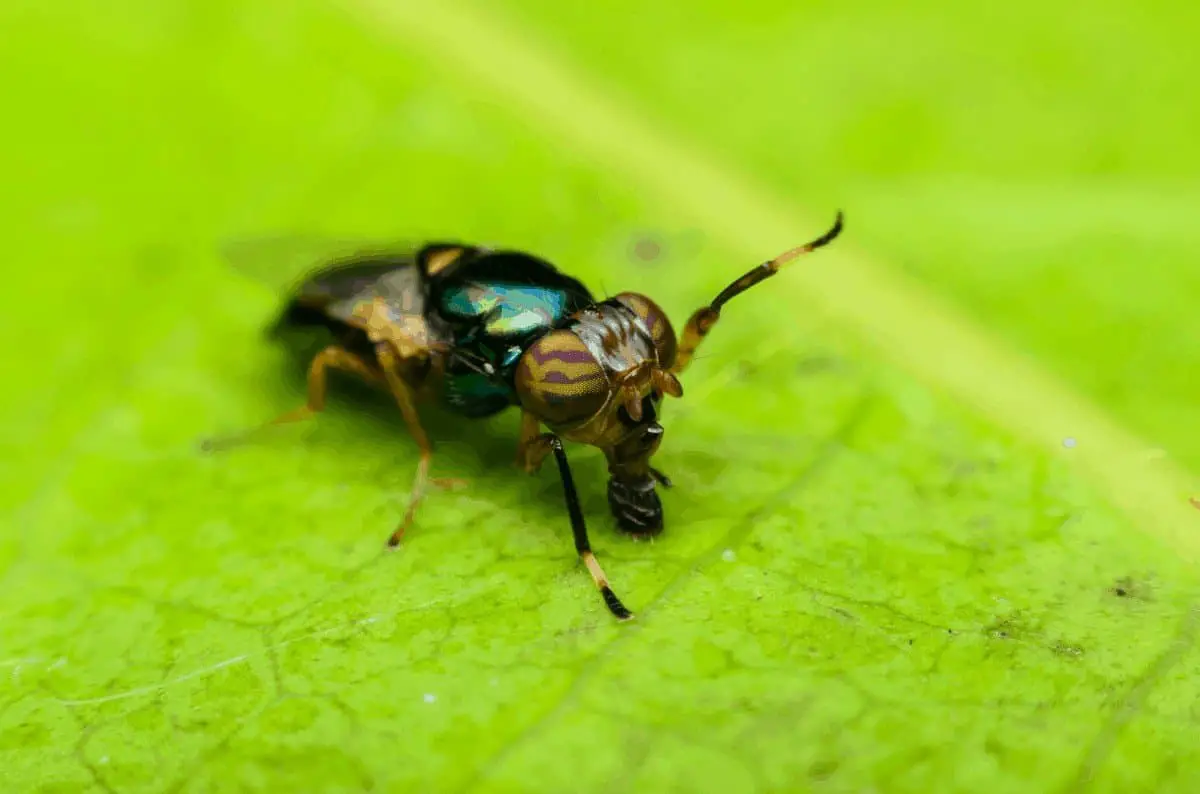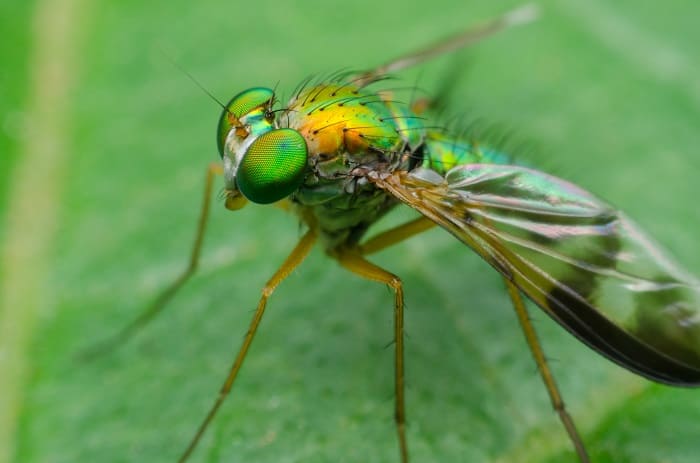Last Updated on June 21, 2023 by Tony Manhart
Pest control has always been an essential component of being a successful gardener. We love our beautiful flowers and plants, and so do numerous pests like aphids, leafhoppers, fungi, and other organisms that want to eat the leaves and stems. These pests frequently carry diseases and can destroy a plant, making it crucial to eliminate them as soon as possible. So, how to get rid of hoverflies?
One of the most confusing pests for amateur gardeners is the hoverfly. These insects fly around flowers and plants and closely resemble their nasty cousin the wasp. This leads many to wonder just how to get rid of them. How can you eliminate them?
How to Get Rid of Hoverflies
The short answer, don’t. Hoverflies are an essential part of the ecosystem and play an important role for gardeners. Flies are responsible for pollinating plants and working as a natural pest control. They resemble bees, wasps, and yellowjackets with their bright coloring and slender bodies. Hoverflies actually pose no threat to humans or even the plants and flowers they love. If they are outside and have not invaded your home, then there is no reason to get rid of them.
However, if they are being a nuisance, it’s always possible to repel them rather than outright killing them. There are dozens of natural and synthetic repellents available in the commercial market, although it varies how plant-friendly they are. If you are interested in more earthy repellents, such as herbs and plants, then this guide has some excellent information for you.
How to Get Rid of Hoverflies: What Is a Hoverfly?
Hoverflies are a unique insect often mistaken for their more dangerous counterparts because of their striped yellow and black bodies. These insects are also called flower flies or syrphid flies and eat a broad range of foods, including nectar and pollen. While they don’t mean you or your garden any harm, they can be an annoying menace for gardeners because they have a tendency to get everywhere and make it difficult to enjoy flowers.
The hoverfly will often try to mimic the patterns of wasps, yellowjackets, and bees as a natural defense against predators. However, this can make them an easy target for gardeners, who mistake their bright patterns for more deadly pests.
How to Get Rid of Hoverflies: The Benefits of Hoverflies
One thing many gardeners don’t realize is that hoverflies are actually beneficial to a garden. They serve an important role in the pollination of plants and flowers and are one of the few insects that will work with any flower they come across. At a time when the world is currently experiencing the rapid depopulation of pollinators, eliminating hoverflies entirely can be bad news for a garden.
Hoverflies also play an important role in pest control. They feast on the larvae of more dangerous bugs like aphids and leafhoppers, helping to curb disease among your plants. This promotes a healthier garden and also makes it easy to identify contaminated plants. After all, the hoverflies will continue to return to any affected flowers to eat the pests.
Instead of exterminating hoverflies, more and more gardeners are recommending methods designed to manage the population rather than eliminate it entirely.
Do Hoverflies Sting?
Because the hoverfly mimics natural predators like the wasp or yellowjacket, gardeners assume they sting. However, the hoverfly does not have a stinger and means humans and animals no harm. It is only interested in pollen and any pest larvae that might live in the garden.
Natural Outdoor Repellents
If you would like to get rid of hoverflies outside despite the benefits, then the simplest method is to plant certain herbs that form natural repellents. These include common options like basil, bay leaf, lavender, and mint. Not only will they be effective, but they will also smell amazing and add a little extra greenery to the garden.
How to Get Rid of Hoverflies Indoors
Most gardeners believe the only acceptable time to eliminate hoverflies is when they have flocked indoors and are now in your house. Once out of the garden, hoverflies can become a real nuisance, even if they might be helping your indoor plants.
- Traps: The easiest way to eliminate hoverflies indoors is by treating them like regular flies. Use pest control methods like flypaper, flytraps, and natural methods to catch the pests and stop them from zooming around your head.
Flypaper and flytraps are simple and straightforward. They are composed of a piece of paper or board that has a sticky, attractive glue applied to the surface. The hoverflies are beguiled by the scent wafting from the trap and fly towards it, becoming stuck. This stops them from flying around the house and kills them through starvation.
- Natural methods: If you are interested in more natural methods, gardeners and amateur pest controllers have come up with a variety of ways to stop your fly problem. Eucalyptus oil has been shown to be a natural repellent. You can place drops of the oil on strips of paper or fabric and place them near doors and windows so the hoverflies don’t come in and are tempted to fly out. You can also tempt them with a vinegar and water mixture, where the hoverflies will drown.
- Insecticides: If you’re still struggling, you can also move to traditional pesticides like powders and sprays. These are highly effective but often contain toxic ingredients that could be a hazard to you, your children, and your pets. Try to use these sparingly and place them in locations where the flies will be attracted to them. But your family and pets will leave them alone.
Video
Learn more about natural methods to repel insects in the following video:
Conclusion
Although hoverflies look intimidating, they are actually one of the most beneficial insects to have in your garden. They have a similar function to bees and are capable of pollination and pest control. If you would like to get rid of them, it is best to use natural herbs as a repellent. These don’t hurt the hoverflies but will stop them from buzzing around your head while you’re trying to work in the garden.
FAQs
What are hoverflies attracted to?
Hoverflies are attracted to flowers and other nectar-producing plants. They also like areas where there is a lot of decomposing plant material. Hoverflies are attracted to the smell of rotting vegetable material, urine, and sulfur that emanates from rotting organic material.
How do you get rid of circling flies on a patio?
There are many ways to get rid of circling flies. You can use a variety of fly traps, such as vinegar and sugar, or you can use a chemical spray. Most people use fly swatters as a last resort option because it is not environmentally friendly. In addition, some people fear that the swatter will harm them or their pets if they use it.
Although fly swatters are not safe for humans and pets, they still have a place in pest control.
Are Hoverflies good for your garden?
If you have a garden and are wondering whether the Hoverflies are good for your garden, the answer is yes. They do not harm any plant or tree in your garden.
Hoverflies are a good option when it comes to pest control. They can actually help with garden pests such as aphids, mosquitoes and mites.
Hoverflies are a type of insect that does good for your garden by consuming other insects. They are able to get rid of mosquito larvae, aphids and mites from trees and plants.
What eats hover flies?
They only eat other insects like aphids and thrips. That's why they're so small in size and don't really bother people much. Hover flies produce a substance called honeydew which is attractive for ants and other insects like them because of the sugar content it contains. Ants will therefore help hover fly by cleaning off their bodies from the dead bugs around you!
Why are there so many hoverflies around?
The phenomenon of a sudden increase in hoverflies is called hoverfly season. This is a common occurrence in the summertime and can be found across various regions of the world.
Hoverfly season follows a pattern in which there are more flies than usual and then they die off at the end of the season. The reason for this pattern is that these insects fly around looking for mates and reproducing.
This phenomenon has been studied by entomologists since it was first seen in North America during the mid-19th century, but scientists still aren't sure what causes this to happen.
What are hover flies attracted to?
Hover flies are a type of fly that is sometimes called "mongrels" because they are attracted to rotting or decaying matter. These flies typically live in groups and prefer to feed on rotting fruits, plants, and meat.
Hover flies are attracted to rotting meat and fruit. They will also feed on carrion, feces, plant debris and other dead vegetation. If you see a hover fly hovering around your house, it is likely that it is attracted to the smell of something decomposing such as putrid meat or fruit that has fallen from the tree into your garden.
Additionally, if you see a hover fly flying near your head or face, it may be looking for a place to lay its eggs in moist areas such as grass or dirt-covered surfaces.
Are hoverflies bad?
Hoverflies are insects that are harmless to humans. They can be found in large numbers on flowers, plants, trees and other organic materials. These insects do not harm anything when they fly around and although some people might think that these are bad because of the way they look, we should not get rid of them because they provide a service to the plant life.
Tony Manhart is a passionate gardener who has been tending to gardens for over 20 years. He takes pride in creating beautiful outdoor spaces with plants, trees, and shrubs that can thrive in any environment. He loves to share his knowledge with others and has taught classes on gardening basics and advanced techniques. He is committed to sustainability, using natural and organic methods to create and maintain gardens. He also works with local organizations to create green spaces for communities. When he’s not gardening, Tony enjoys hiking, reading, and spending time with his family.



